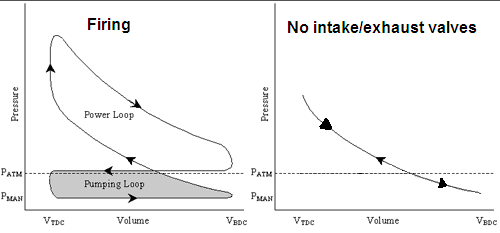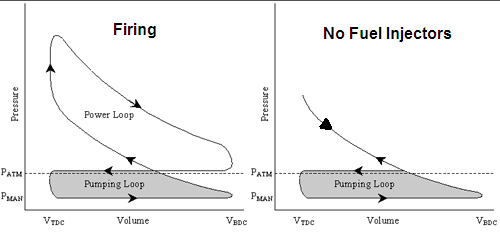Quote:
Originally Posted by Frank Lee

Repeat after me: Pumping losses. Pumping losses. Pumping losses.
I doubt if it makes a difference if you sequence amongst cylinders or go whole hog.
|
To expand upon Frank Lee's explanation as to why this won't work for a gasoline engine:
We can all agree that shutting off half of the cylinders in a gasoline engine will make the remaining cylinders work harder. This will cause the throttle valve to open so that the remaining cylinders can get more air. I've included two diagrams below, of an idealized throttled gasoline engine. One is with true valve-based cylinder deactivation, and the other is by simply cutting off the fuel injector to achieve cylinder deactivation.

For a true cylinder deactivation system, the valves are deactivated, and nothing is pumped through a cylinder. This makes the p-v diagram of the engines look like the above. Half of the cylinders are actually pumping, while the other half are simply compressing and expanding the captive air mass within the cylinder. The net result is that engine vacuum is decreased, causing the engine to work less in drawing a vacuum. This results in fuel savings.

Now, for schemes which only shut off the fuel injector, the deactivated cylinders are still pumping air through them. This will cause vacuum to rise between that of an engine with true cylinder deactivation, and that of a normal working engine. It'd have to, because the deactivated cylinders are still contributing to vacuum formation.
Now, since the deactivated cylinders are still doing work, that work has to be taken away from the generated power that the firing pistons are producing. The firing cylinders are effectively making twice the amount of effort they'd normally have to make to draw the vacuum. Worse yet, the combined effort for each firing cylinders is going to be more than for the normal engine that doesn't have any deactivated cylinders!
No, simply shutting off fuel injectors will not save gas. It'd have exactly the opposite effect.